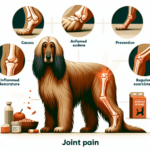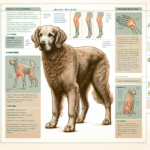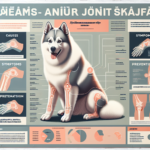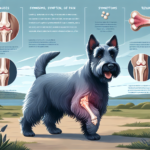Kuvasz Joint Pain: Causes, Symptoms, Prevention, and Treatment
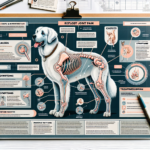
Introduction
The Kuvasz is a majestic and ancient breed, known for its loyalty, intelligence, and protective nature. Originating from Hungary, the Kuvasz was historically used as a guardian of livestock, a role that required both physical strength and agility. This breed is characterized by its large size, muscular build, and thick white coat, which provides protection against harsh weather conditions. Despite their imposing appearance, Kuvasz dogs are gentle and affectionate with their families.
Like many large breeds, the Kuvasz is prone to certain health issues, with joint pain being a significant concern. Joint health is crucial for maintaining the mobility and quality of life of these dogs, making it an important topic for Kuvasz owners to understand and address.
Breed-Specific Joint Pain Risks
Genetic Predisposition
The Kuvasz is genetically predisposed to several joint-related issues, including hip dysplasia, elbow dysplasia, and arthritis. Hip dysplasia is a condition where the hip joint does not fit properly into the hip socket, leading to pain and mobility issues. Elbow dysplasia involves abnormal development of the elbow joint, causing lameness and discomfort. Arthritis, a degenerative joint disease, can also affect Kuvasz dogs, leading to chronic pain and stiffness.
Age-Related Risks
As Kuvasz dogs age, the risk of developing joint pain increases. While young Kuvasz puppies may show early signs of joint issues due to genetic factors, older dogs are more likely to experience joint pain due to wear and tear over time. Owners should be particularly vigilant as their Kuvasz reaches middle age, typically around 5-7 years, and into their senior years.
Activity Level and Joint Stress
The Kuvasz is an active and energetic breed, often used for working or guarding purposes. This high activity level can contribute to joint stress, especially if the dog is involved in strenuous activities such as running, jumping, or herding. While regular exercise is essential for maintaining overall health, it is important to balance activity levels to prevent excessive joint strain.
Common Symptoms of Joint Pain in Kuvasz
General Symptoms
- Limping or favoring one leg
- Stiffness, especially after rest or sleep
- Reluctance to move, jump, or climb stairs
- Decreased activity or playfulness
- Swelling or heat around the joints
- Whining or showing signs of discomfort when touched
Breed-Specific Symptoms
In Kuvasz dogs, joint pain may manifest more prominently due to their size and weight. Owners may notice a pronounced limp or difficulty in getting up from a lying position. Additionally, Kuvasz dogs may become more reserved or less willing to engage in activities they previously enjoyed.
When to Consult a Vet
If you observe any of the above symptoms in your Kuvasz, it is important to consult a veterinarian promptly. Early diagnosis and intervention can help manage joint pain more effectively and improve your dog’s quality of life. Persistent limping, noticeable discomfort, or any sudden changes in behavior should be addressed by a professional.
Preventive Measures for Joint Health
Exercise Recommendations
Regular, moderate exercise is key to maintaining joint health in Kuvasz dogs. Activities such as walking, swimming, and gentle play can help keep joints flexible and muscles strong without causing excessive strain. Avoid high-impact activities like jumping or running on hard surfaces, which can exacerbate joint issues.
Dietary Suggestions
A balanced diet rich in essential nutrients is crucial for joint health. Consider incorporating foods or supplements that contain glucosamine, chondroitin, and omega-3 fatty acids, which support joint function and reduce inflammation. Consult your veterinarian for specific dietary recommendations tailored to your Kuvasz’s needs.
Weight Management
Maintaining a healthy weight is vital for reducing joint stress in Kuvasz dogs. Excess weight can put additional pressure on the joints, exacerbating pain and mobility issues. Monitor your dog’s weight regularly and adjust their diet and exercise routine as needed to keep them at an optimal weight.
Early Screening and Monitoring
Regular veterinary check-ups and early screening for joint issues can help catch problems before they become severe. Discuss with your vet about breed-specific screening tests, such as X-rays or genetic testing, to identify any predispositions to joint conditions. Early intervention can significantly improve outcomes for your Kuvasz.
Treatment Options for Joint Pain
Non-Surgical Treatments
Non-surgical treatments for joint pain in Kuvasz dogs include medications, physical therapy, and lifestyle adjustments. Anti-inflammatory drugs and pain relievers can help manage symptoms, while physical therapy can improve mobility and strengthen muscles. Lifestyle changes, such as providing a comfortable resting area and avoiding high-impact activities, can also alleviate joint pain.
Surgical Options
In severe cases, surgical intervention may be necessary to address joint pain. Common surgeries for joint issues in Kuvasz dogs include hip replacement, elbow surgery, and arthroscopy. These procedures can provide significant relief and improve mobility, but they also come with risks and require a thorough discussion with your veterinarian.
Alternative Therapies
Alternative treatments such as acupuncture, hydrotherapy, and massage can complement traditional treatments and provide additional relief for joint pain. Acupuncture can help reduce pain and inflammation, while hydrotherapy offers low-impact exercise that supports joint health. Massage therapy can improve circulation and reduce muscle tension around the joints.
Lifestyle and Management Tips
Daily Care Routine
A consistent daily care routine can help manage joint pain in Kuvasz dogs. This may include gentle exercise, a balanced diet, and regular administration of any prescribed medications or supplements. Providing a comfortable resting area with orthopedic bedding can also support joint health.
Modifying the Home Environment
Making adjustments to your home environment can make a significant difference for a Kuvasz suffering from joint pain. Consider installing ramps to help your dog navigate stairs or get into vehicles. Provide non-slip flooring to prevent falls and ensure that your dog has easy access to their favorite resting spots.
Long-Term Management
Long-term management of joint pain involves ongoing monitoring and adjustments to your dog’s care routine. Regular veterinary check-ups, weight management, and appropriate exercise are essential components. Stay informed about new treatments and therapies that may benefit your Kuvasz and be proactive in addressing any changes in their condition.
FAQs About Kuvasz and Joint Pain
What are the early signs of joint pain in Kuvasz dogs?
Early signs of joint pain in Kuvasz dogs include limping, stiffness, reluctance to move, and decreased activity levels. If you notice any of these symptoms, consult your veterinarian for a thorough evaluation.
Can joint pain in Kuvasz dogs be prevented?
While genetic predispositions cannot be entirely prevented, you can take steps to reduce the risk and severity of joint pain. This includes maintaining a healthy weight, providing appropriate exercise, and ensuring a balanced diet with joint-supporting nutrients.
Are there specific exercises that are better for Kuvasz dogs with joint pain?
Low-impact exercises such as walking, swimming, and gentle play are ideal for Kuvasz dogs with joint pain. Avoid high-impact activities like jumping or running on hard surfaces, which can exacerbate joint issues.
What dietary supplements can help with joint health in Kuvasz dogs?
Supplements containing glucosamine, chondroitin, and omega-3 fatty acids can support joint health in Kuvasz dogs. Always consult your veterinarian before adding any supplements to your dog’s diet.
When should I consider surgery for my Kuvasz’s joint pain?
Surgery may be considered if non-surgical treatments are not providing sufficient relief and your dog’s quality of life is significantly affected. Discuss the potential benefits and risks with your veterinarian to determine the best course of action.
Conclusion
Joint pain is a common concern for Kuvasz dogs, but with proper care and attention, it can be managed effectively. Understanding the breed-specific risks, recognizing early symptoms, and taking preventive measures are crucial steps in ensuring your Kuvasz’s joint health. Regular veterinary consultations, a balanced diet, appropriate exercise, and weight management are key components of a comprehensive joint care plan. By staying informed and proactive, you can help your Kuvasz lead a happy, active, and pain-free life.

